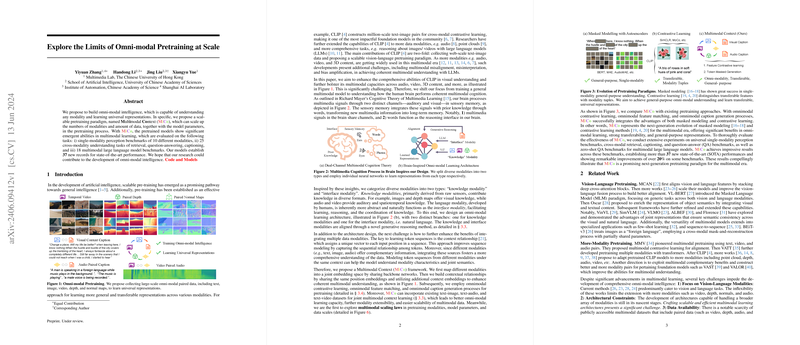Insights into the Multimodal Context Framework for Omni-modal Pretraining
The academic paper titled "Explore the Limits of Omni-modal Pretraining at Scale" introduces a sophisticated approach to omni-modal intelligence via the proposed Multimodal Context (MiCo) framework. The core objective of the framework is to enable comprehensive understanding across diverse data modalities, thereby facilitating the learning of universal representations that are efficiently transferable across various tasks. The primary innovation lies in the scalable pretraining paradigm, which systematically scales up data modalities, dataset size, and model parameters concurrently.
Main Contributions
The paper makes significant contributions in the following areas:
- Scalable Pretraining Architecture: The authors propose a dual-branch architecture for the omni-modal learning process, one branch focusing on knowledge modalities like image and audio, and the other on natural language, allowing for distinct yet interconnected learning processes. This design emulates the human cognitive process in multimedia learning, inspired by cognitive theories.
- Rich Multimodal Dataset: A substantial effort went into constructing an extensive dataset containing multimodal paired data across dimensions such as text, image, video, depth, and more. This dataset underpins the scalability of the proposed framework.
- Multimodal Context Construction: The approach effectively aligns diverse modalities by integrating them into a unified representation space. This alignment is reinforced by shared position embeddings and advanced generative reasoning techniques, fostering a cohesive understanding across modalities.
- Outstanding Empirical Results: The framework establishes new state-of-the-art results across 37 benchmarks, confirming the efficacy of the proposed omni-modal learning strategy. Its performance spans single-modality perception benchmarks, cross-modality understanding, and multimodal LLM benchmarks, demonstrating both breadth and depth in applicable tasks.
Implications and Future Directions
The implications of this research are noteworthy. Practically, the framework could drive significant advancements in fields requiring comprehensive multimodal understanding, such as autonomous systems, advanced search and retrieval systems, and more nuanced AI-driven content creation tools. Theoretically, the approach challenges conventional models limited by modality-specific confines, promoting a paradigm shift towards more general and unified AI models.
Regarding future development, a few trajectories are promising. Enhancing the architectural robustness to accommodate additional modality types, such as 3D as well as more abstract modalities, could further optimize its universal applicability. Additionally, exploring further scalability in terms of data, models, and computational efficiency could lead to even more profound capabilities, potentially approaching the long-sought goal of general AI.
By successfully amalgamating insights from human cognitive processes, large-scale data handling, and state-of-the-art model design, this research provides crucial stepping stones toward realizing sophisticated omni-modal artificial intelligence systems capable of functioning across multi-faceted environments.
In conclusion, the paper underscores the immense potential of the Multimodal Context framework in advancing omni-modal intelligence. Its innovative architecture, substantial dataset application, and remarkable empirical success collectively advocate for a holistic approach to developing future AI models that transcend the limitations of modality-specific intelligence.
